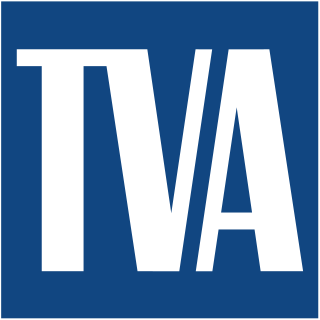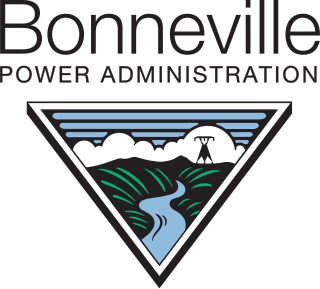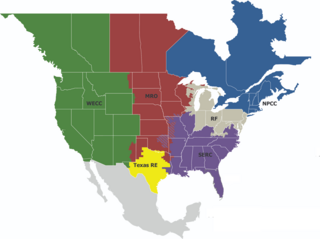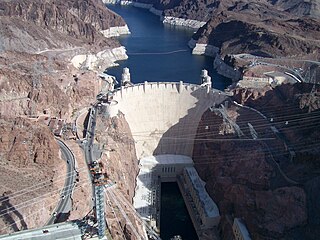Related Research Articles

The Tennessee Valley Authority (TVA) is a federally owned electric utility corporation in the United States. TVA's service area covers all of Tennessee, portions of Alabama, Mississippi, and Kentucky, and small areas of Georgia, North Carolina, and Virginia. While owned by the federal government, TVA receives no taxpayer funding and operates similarly to a private for-profit company. It is headquartered in Knoxville, Tennessee, and is the sixth largest power supplier and largest public utility in the country.
Southern Company is an American gas and electric utility holding company based in the southern United States. It is headquartered in Atlanta, Georgia, with executive offices also located in Birmingham, Alabama. The company is the second largest utility company in the U.S. in terms of customer base, as of 2021. Through its subsidiaries it serves 9 million gas and electric utility customers in 6 states. Southern Company's regulated regional electric utilities serve a 120,000-square-mile (310,000 km2) territory with 27,000 miles (43,000 km) of distribution lines.

The Tennessee River is the largest tributary of the Ohio River. It is approximately 652 miles (1,049 km) long and is located in the southeastern United States in the Tennessee Valley. The river was once popularly known as the Cherokee River, among other names, as the Cherokee people had their homelands along its banks, especially in what are now East Tennessee and northern Alabama. Additionally, its tributary, the Little Tennessee River, flows into it from Western North Carolina and northeastern Georgia, where the river also was bordered by numerous Cherokee towns. Its current name is derived from the Cherokee town, Tanasi, which was located on the Tennessee side of the Appalachian Mountains.

The Bonneville Power Administration (BPA) is an American federal agency operating in the Pacific Northwest. BPA was created by an act of Congress in 1937 to market electric power from the Bonneville Dam located on the Columbia River and to construct facilities necessary to transmit that power. Congress has since designated Bonneville to be the marketing agent for power from all of the federally owned hydroelectric projects in the Pacific Northwest. Bonneville is one of four regional Federal power marketing agencies within the U.S. Department of Energy (DOE).
A utility cooperative is a type of cooperative that is tasked with the delivery of a public utility such as electricity, water or telecommunications to its members. Profits are either reinvested for infrastructure or distributed to members in the form of "patronage" or "capital credits", which are dividends paid on a member's investment in the cooperative.

The Southwestern Power Administration (Southwestern) is an agency of the U.S. Department of Energy. Southwestern's mission was established by Section 5 of the Flood Control Act of 1944. The agency is a power marketing administration responsible for marketing the hydroelectric power produced at 24 United States Army Corps of Engineers multipurpose dams. By law, the power and associated energy are marketed to publicly held entities such as rural electric cooperatives and municipal utilities. Southwestern has over one hundred such "preference" customers which ultimately serve over 10 million end use customers.

As one of the four power marketing administrations within the U.S. Department of Energy, the Western Area Power Administration (WAPA)'s role is to market wholesale hydropower generated at 57 hydroelectric federal dams operated by the Bureau of Reclamation, United States Army Corps of Engineers and the International Boundary and Water Commission. WAPA delivers this power through a more than 17,000-circuit-mile, high-voltage power transmission system to more than 700 preference power customers across the West. Those customers, in turn, provide retail electric service to more than 40 million consumers. WAPA is headquartered in the Denver, Colorado suburb of Lakewood, Colorado.

The National Register of Historic Places in the United States is a register including buildings, sites, structures, districts, and objects. The Register automatically includes all National Historic Landmarks as well as all historic areas administered by the U.S. National Park Service. Since its introduction in 1966, more than 90,000 separate listings have been added to the register.
The Power Marketing Administration (PMA) is a United States federal agency within the Department of Energy responsible for marketing hydropower, primarily from multiple-purpose water projects operated by the Bureau of Reclamation, the U.S. Army Corps of Engineers, and the International Boundary and Water Commission.
Santee Cooper, also known officially from the 1930s as the South Carolina Public Service Authority, is South Carolina's state-owned electric and water utility that came into being during the New Deal as both a rural electrification and public works project that created two lakes and cleared large tracts of land while building hydro-electric dams and power plants. Its headquarters are located in Moncks Corner, South Carolina.
SCANA Corporation was a regulated electric and natural gas public utility. The company was based in Cayce, South Carolina, a suburb of Columbia, South Carolina. Following the Nukegate scandal, the company's stock fell and the company was in disrepair. In January 2019, SCANA was acquired by Dominion Energy. The corporate name SCANA was not an acronym, but was taken from the letters in South Carolina.
Oglethorpe Power Corporation is a medium-sized electric utility in Georgia, United States. Formed in 1974, Oglethorpe is a not-for-profit cooperative owned by the 38 electric membership corporations that it serves. The utility's headquarters are in Tucker, Georgia.

The SERC Reliability Corporation (SERC) is responsible for ensuring a reliable and secure electric grid across 16 southeastern and central states. The SERC region lies within the Eastern Interconnection, and includes the states of Alabama, Georgia, Mississippi, Missouri, North Carolina, South Carolina, Tennessee, and portions of Arkansas, Illinois, Kentucky, Louisiana, Oklahoma, Texas, Virginia, and Florida.
There is a large array of stakeholders that provide services through electricity generation, transmission, distribution and marketing for industrial, commercial, public and residential customers in the United States. It also includes many public institutions that regulate the sector. In 1996, there were 3,195 electric utilities in the United States, of which fewer than 1,000 were engaged in power generation. This leaves a large number of mostly smaller utilities engaged only in power distribution. There were also 65 power marketers. Of all utilities, 2,020 were publicly owned, 932 were rural electric cooperatives, and 243 were investor-owned utilities. The electricity transmission network is controlled by Independent System Operators or Regional Transmission Organizations, which are not-for-profit organizations that are obliged to provide indiscriminate access to various suppliers to promote competition.

Hydroelectricity is, as of 2019, the second-largest renewable source of energy in both generation and nominal capacity in the United States. In 2021, hydroelectric power produced 31.5% of the total renewable electricity, and 6.3% of the total U.S. electricity.

Wind power in Tennessee has most potential in East Tennessee along the North Carolina border. The state has not passed renewable portfolio standard legislation and there is just one utility-scale wind farm with 15 operating turbines and previously 3 test turbines. The Tennessee Valley Authority (TVA), based in Knoxville, imports wind-generated electricity into its service area which includes Tennessee. US Senator Lamar Alexander from Tennessee is an outspoken critic of wind power.

Wind power in Kentucky has limited potential for development within the state since there are generally low wind speeds, though there are specific locations where it can be effective. The state has not passed renewable portfolio standard legislation and there are no commercial-scale wind turbines. Kentucky may benefit from the development of wind power in Tennessee, an adjoining state with which it is collaborating, and from efforts by the Tennessee Valley Authority to both develop and import wind-generated electricity into the region.
References
- ↑ "Generation – Southeastern Power Administration". Energy.gov. Retrieved 2023-03-20.
- 1 2 3 4 About Us, Southeastern Power Administration website, accessed January 23, 2009
- ↑ Power Marketing Administrations, U.S. Department of Energy website, accessed January 23, 2009
- ↑ Quick Facts, Southeastern Power Administration website, accessed January 23, 2009
- ↑ http://www.cfo.doe.gov/budget/04budget/content/pmas/sepa.pdf [ dead link ]
- ↑ Rate Schedules, Southeastern Power Administration website, accessed January 23, 2009
- ↑ Southeastern Power Administration Announces New Administrator, Southeastern Power Administration website, accessed January 23, 2009
